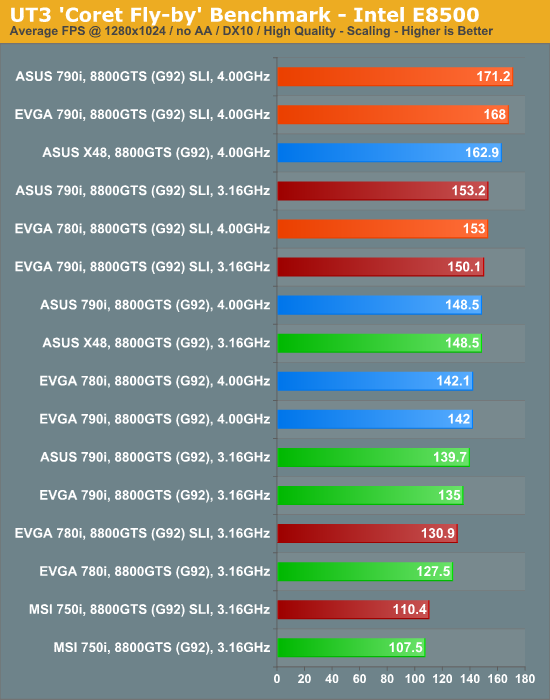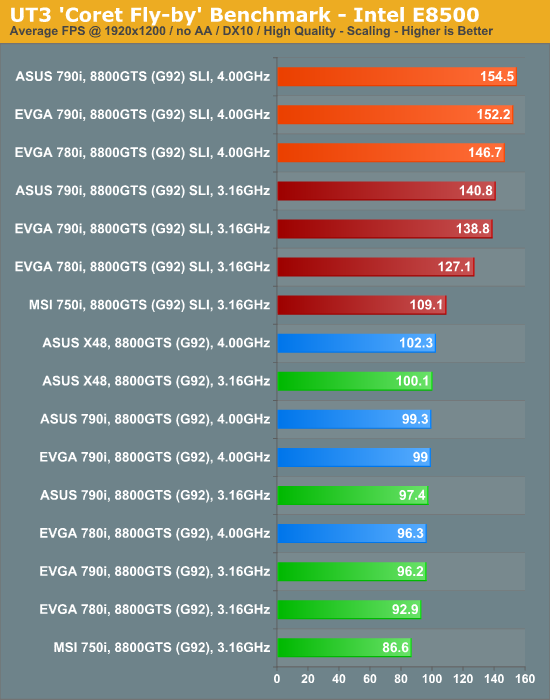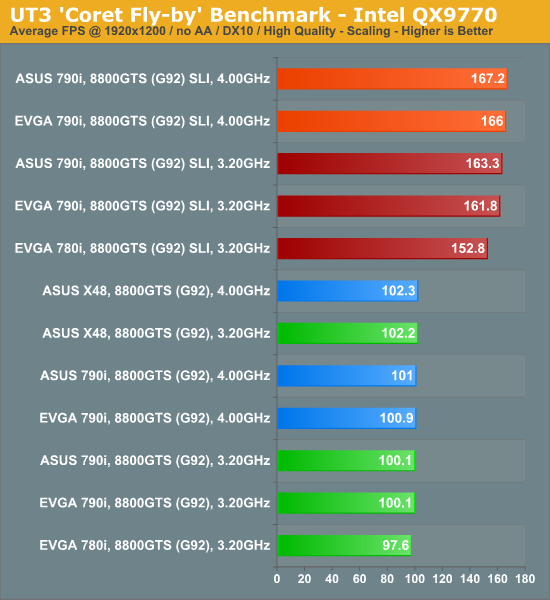ASUS Striker II Extreme: Mucho Bang, Mucho Bucks
by Kris Boughton on April 11, 2008 7:00 AM EST- Posted in
- Motherboards
Game Testing - Unreal Tournament 3
Unreal Tournament 3 (UT3) continues to be one of our favorite games and as such tends to be one of the more scrutinized titles when it comes to graphics performance. This fast-action first-person shooter demands high frame rates if you are to be successful playing against others online. The slightest bit of lag or the occasional jerky picture response can quickly degrade the game playing experience to the point of absolute frustration. UT3 also happens to be quite demanding when it comes to CPU performance.

Much like Crysis, UT3 frame rates at lower resolutions will suffer with slower memory subsystems. We have found UT3 to be very latency sensitive, which is one of the reasons why the Intel X48 chipset stands out so well at 1280x1024.

By moving to the higher 1920x1200 resolution, we can see exactly where the graphic system becomes the bottleneck and limits the average frame rate to about 100FPS regardless of CPU speed. As we have seen before, the 750i and 780i fall behind in SLI, with as much as a 50% performance improvement to be had when moving up to 790i. At these frame rates though, this extra performance margin would be much better put to use with 4xAA/16x AF turned on.

Unlike Crysis, UT3 benefits from the use of our QX9770, more so without SLI than with. The ever-ensuing tradeoff between which subsystem becomes the performance limiter should stick out as a common theme by now. Discounting SLI configurations, Intel's X48 holds the lead here due to the reduced memory latencies experienced with this chipset.

At higher resolutions, UT3 does benefit from the QX9770 CPU, but not because of what you might think. Improved SLI scaling due to the abundance of processing power allows for slightly better average frame rates when using more than one GPU. The lower cap at around 100FPS is still present with the single-GPU configurations. If we were going to build a SLI system for playing UT3, it would be with the goal of running high AA/AF levels at a resolution of 1920x1200.










23 Comments
View All Comments
takumsawsherman - Saturday, April 12, 2008 - link
But for $400, you only get Firewire 400. Is that like a key, or something? If we pay $800 for a board, will they finally feel as though they can afford to add Firewire800, as Gigabyte did on their $200 boards like 3 or 4 years ago?When they talk about adding firewire itself to a board, does it never occur to them that a faster variation has existed for 5 or 6 years now? How insulting.
Grandpa - Saturday, April 12, 2008 - link
It doesn't matter what the price, performance, make, or model. If the board is unstable I don't want it! I had an Abit board once with a VIA chipset. It corrupted data when large files were transferred between drives. Several BIOS updates later, with the performance down to a crawl, it still corrupted data. Because of that ugly bad memory, stability is number one important for me. So this review is very relevant to others like myself.Super Nade - Friday, April 11, 2008 - link
As far as I know, the capacitors you mention are made by Fujitsu's Media division (FP-Cap series), not Fairchild semiconductor. Fujitsu did try to gobble up Fairchild in the 80's, but the US government killed the deal. Apart from this, I am not aware of any connection between these two companies.Here is the link--> http://jp.fujitsu.com/group/fmd/en/services/capaci...">http://jp.fujitsu.com/group/fmd/en/services/capaci...
S-N
Stele - Saturday, April 12, 2008 - link
Super Nade's right. The vendor marking on the capacitors - which have been the same for almost all such solid electrolytic polymer caps used on Asus boards for some time now - is very much that of Fujitsu: a letter 'F' in Courier-esque font between two horizontal lines.Interestingly - and confusingly - however, once upon a time this logo was indeed that of Fairchild Semiconductor... the deal that almost happened in the 80s may have something to do with Fujitsu's current use of the said logo. Either way, Faichild Semi have long since changed to their current logo (a stylised italic 'f') so today, any current/new electronic/semiconductor component carrying the F-between-bars logo is almost certainly a Fujitsu product.
jojo29 - Friday, April 11, 2008 - link
Just wondering how the Anandtech's Choice P5E3 Premium ( which i plan on buying) stacks up against this Striker? Any comments? Or did i miss something in the aricle as i was only able to skim through it, as im at work atm, and dontcoughwantcoughtogetcaughtbymybosscough...kjboughton - Friday, April 11, 2008 - link
We used one X48 motherboard in this review and it was the ASUS P5E3 Premium. Enjoy the full read when you make it home. ;)ImmortalZ - Friday, April 11, 2008 - link
You mention that overclocking the PCI-E bus provided tangible performance benefits on the EVGA board.Did you read about the rumblings around the net about some G92 based cards overclocking their GPU with the PCI-E bus? There are supposedly two clock sources for these type of cards - one on board and the other slaved to the PCI-E bus.
Are you sure that the performance improvement is not because of this anomaly?
CrystalBay - Friday, April 11, 2008 - link
Hi Kris, while UT3 does scale very well with multi-core. The game it self has no DX10 support as of yet. Hopefully EPIC will will enable it in a future update...Glenn - Friday, April 11, 2008 - link
All the benchies and comparisons are great, but how does it compare to a P35 board? A 965 or X38 board? I doubt you will convert those that already own an X48 and I (P35) have no point of reference within this article to see if I'm 5, 10 or 25% behind the preformance curve?Rolphus - Friday, April 11, 2008 - link
Interesting review... only one question though. Why use the 32-bit version of Crysis on Vista x64? Is there an issue with the 64-bit version that I don't know about?